Capella University
BHA-FPX4104: Strategic Leadership and Workforce Planning in Health Care
Prof. Yvonne Alles
December 4, 2023
Human Resources: Strategy and Competitive Advantage
Part 1: Comparison of Current Workforce to Future Needs.
As a member of the Department of Human Resources, I advise CEOs on strategic planning. As a leader at St. Anthony Medical Center (SAMC), I am responsible for providing a report detailing my findings and assessing the hospital’s problems. Because of a chemical leak triggered by a train disaster, the medical facility is presently overrun by patients. In the initial case, the emergency room nurse experienced turfing. This facility receives more patients than other hospitals as it effectively treats the neighborhood, especially low-income and uninsured citizens.
A laboring pregnant woman comes to the facility. The lady speaks a foreign language, but fortunately, the accompanying nurse can comprehend and interpret her speech. This patient recounts that another facility dismissed her. In addition to having no medical insurance, the lady could have been dismissed at the second hospital owing to the language barrier. The CEO explains what transpired. We are aware that the communication barrier has become a problem, but happily, due to the nurse accompanying the laboring lady, they prevented errors. The CEO wants to learn about the procedure for interpreters so that this does not occur again. Lack of communication might result in negative outcomes.
The second case identifies staffing challenges as a problem. In the Pediatric intensive care unit (PICU), the nursing management seeks to optimize staff utilization, however, due to the influx of patients, the hospital has insufficient beds, and the head nurse is short two evening nursing staff and 3-night shift nursing staff. They tried to get an additional nurse from a different location, but the nurse fled after witnessing the pandemonium. A greater rate of nursing personnel attrition may result from recruiting untrained and unable-to-perform-certain-tasks nurses from various facilities. Because of a scarcity of prospective trainers, high attrition, and unequal workforce allocation, the nursing sector experiences persistent labor shortages (Haddad, 2020). Based on the specialty, shortages will be greater.
Floating reassigns personnel from one division to another depending on patient population and severity (David, 2022). Floating may generate anxiety, overburdening, and dissatisfaction since it forces nurses out of their comfort zone. As seen at St. Anthony Medical Center, understaffing may also impact leadership characteristics. The supervising nurse within the PICU has demonstrated an ongoing source of conflict between the personnel and administration. In a conference, the leading nurse discusses the necessity for additional personnel and the attentiveness of the CEO; however, the CEO feels that more employees cannot fit their budget.
The existing situation at St. Anthony Medical Center indicates insufficient nurses to care for the anticipated volume of patients. As noted before, this hospital is a teaching facility that serves a variety of community populations, such as patients without medical insurance. Their personnel should fulfill their demands. The standard nurse-to-patient ratio in any medical-surgical facility should be 1:5. According to the assessment’s nursing policy, the nurse-to-patient ratio in the PICU ought to be 1:2 or 1:3 patients. As demonstrated, SAMC is not prepared for the teaching hospital role when an influx of patients of this kind occurs. Regarding communication issues, if the accompanying nurse was not there and was uninformed of the patient’s situation, she may have been given anything that could have resulted in a negative outcome. This issue continues to interfere with the hospital’s objectives, such as delivering excellent patient care.
Part 2: Staffing Plan and Competitive Advantage.
Staffing in healthcare is crucial for patient experience and treatment quality. A staffing strategy is a series of activities taken to ensure that a hospital, such as St. Anthony Medical Center, has the correct number of jobs and functions and suitable personnel with the required abilities. As a member of the Human resources department, I will evaluate and determine St. Anthony Medical Center’s personnel requirements. Their primary concerns are a communication strategy (translators) and more qualified nurses to cover shifts. SAMC requires a more diverse staff, including translators and nurses capable of performing any duty.
It is far simpler to replace doctors with NPs and PAs than to replace nurses. Utilizing traveling nurses is one option to address the nursing shortage. Because they can participate in almost everything, they can be employed in any role. Evidence-based studies demonstrate that a versatile nurse has better patient outcomes than nurses specializing in a particular area (Hunt, 2018). Traveling nursing staff do not always need money from the employer. Compared to a round-the-clock nurse, a hospital may save money by alternating between itinerant nurses to stick to your expenditure.
Utilizing nursing staff from other nations is an alternative approach. This may increase patient contentment and reduce the hospital’s requirement for interpreters. This accomplishes two goals at once. Another alternative would be to provide incentives to nurses contemplating entering the profession. This could be employed to convince people to enter your group.
St. Anthony’s ought to incorporate interpreters into their personnel strategy. Hospital translators facilitate communication between individuals with minimal English abilities and the deaf. Utilizing healthcare translators in the emergency room will improve the level of care delivered to the clients and let them feel more at ease and better able to communicate their concerns. There are several kinds of interpreters available for usage. This comprises in-person, telephone, and remote digital interpreters (Akorbi, 2022). Multiple regulations, notably the Affordable Care Act (ACA), mandate that federally funded providers offer translators and written information to clients with limited English proficiency and deafness. If you violate this law, this may become a significant problem. They may withdraw federal funding. The observance of the law may avoid future infractions and compliance concerns.
A yearly review is one of three methods for determining whether staffing objectives have been fulfilled. This enables us to review the enhancements and reevaluate anything that requires modification. Conducting patient satisfaction studies would be an additional implementation. This allows organizations to determine whether there is a change in treatment outcomes. Thirdly, organizations should establish personnel self-evaluation and training. Thus, you may reassess the workforce to confirm their suitability for the position.
The organization would create a competitive edge via high-quality care, reliability, and rapid service turnaround. Since HR can supply excellent personnel via the staffing strategy and by placing individuals where they fit, we will keep our workers satisfied, maintaining patient satisfaction.
References
Akorbi. (2022). U.S Healthcare interpreter staffing. https://akorbi.com/us-healthcareinterpreter-staffing/
Davies K. (2022) Advance healthcare networks for nurses. Float assignments. Nursing.advanceweb com/continuing-education/CE-Articles/Float.Assignment.aspx
Haddad, L.M., Annamaraju, P., Toney-Butler, T.J. (2020). Nursing shortage. StatPearls Publishing. https://www.ncbi.nlm.nih.gov/books/NBK493175/
Hunt, P. (2018). Developing a staffing plan to meet inpatient unit needs, Nursing Management, 49(5), 24-31 doi:10.1097/01.NUMA.0000532326.62369.9b



